David Suzuki's Blog, page 3
September 19, 2017
Global research uncovers new, threatening ecological impacts from neonicotinoid pesticides
The Task Force on Systemic Pesticides' 2017 assessment of neonics reveals new risks to biodiversity and ecosystems
**OTTAWA **-- Neonicotinoid pesticides pose severe threats to ecosystems worldwide, according to new information contained in an update to the world's most comprehensive scientific review of the ecological impacts of systemic pesticides.
The Task Force on Systemic Pesticides (TFSP) released the second edition of its Worldwide Integrated Assessment of the Effects of Systemic Pesticides on Biodiversity and Ecosystems today in Ottawa. It synthesizes more than 500 studies since 2014, including some industry-sponsored studies. The review also considered fipronil, a closely related systemic pesticide used in Europe.
The updated assessment confirms that neonics have major impacts and represent a worldwide threat to biodiversity, ecosystems and ecosystem services. First introduced in the 1990s, neonics are now the most widely used insecticides in the world. Agricultural applications include seed treatments, soil treatments and foliar sprays. Neonics are also used on trees, in animal insect treatments, and in domestic and commercial turf products.
"Today's findings reiterate the need to stop massive uses of systemic pesticides, including most urgently their prophylactic use in seed treatment," said Jean-Marc Bonmatin, TFSP vice-chair and research scientist at France's National Centre for Scientific Research. "The use of these pesticides runs contrary to environmentally sustainable agricultural practices. It provides no real benefit to farmers, decreases soil quality, hurts biodiversity and contaminates water, air and food. There is no longer any reason to continue down this path of destruction."
The report is composed of three papers reviewing new data on the mode of action, metabolism, toxicity and environmental contamination of neonicotinoids and fipronil; the lethal and sublethal effects of neonicotinoids and fipronil on organisms and their impacts on ecosystems; and the efficacy of neonicotinoids and fipronil in agriculture and alternative approaches to pest control.
"Only a tiny fraction of pesticide use serves its purpose to fight pests. Most simply contaminates the environment with extensive damage to non-target organisms," said Faisal Moola, director-general with the David Suzuki Foundation. "The Canadian government must accelerate its proposed phase-out of the neonic imidacloprid, and end the use of all other neonics without further delay. Our natural ecosystems and food sources depend on it."
In 2013, the European Union imposed a moratorium on certain uses of imidacloprid, clothianidin and thiamethoxam on bee-attractive crops, and is now considering a proposal to extend this moratorium. France's new biodiversity law includes a provision to ban all neonics starting in September 2018.
Clothianidin, imidacloprid and thiamethoxam are the most widely used neonics in Canada. Clothianidin has been among the top 10 insecticides sold in Canada over the past decade.
The PMRA has proposed a three- to five-year phase-out of imidacloprid for agricultural and most other outdoor uses. Its target date for issuing the final decision is December 2018. The PMRA has also initiated special reviews of risks to aquatic insects from clothianidin and thiamethoxam.
"Overall, the global experiment with neonics is emerging as a clear example of pest-control failure," Bonmatin said. "Governments around the world must follow the lead of countries like France to ban neonics and move toward sustainable, integrated pest management models, without delay."
The TFSP's 2017 update will be published in a forthcoming edition of the scientific journal Environmental Science and Pollution Research.
- 30 -
For more information or to arrange an interview, please contact:
Brendan Glauser, David Suzuki Foundation | 604-356-8829 | bglauser@davidsuzuki.org
The Task Force on Systemic Pesticides (tfsp.info), an international group of independent scientists convened by the International Union for Conservation of Nature, is the response of the scientific community to global concern about the impact of neonicotinoid insecticides on biodiversity and ecosystems. In 2015, the TFSP produced the world's first comprehensive scientific assessment of the ecological effects of neonicotinoids: The Worldwide Integrated Assessment of the Effects of Systemic Pesticides on Biodiversity and Ecosystems (WIA). This landmark review considered more than 1,100 peer-reviewed studies as well as data from manufacturers. It identified clear evidence of harm to honeybees as well as to a large number of other beneficial species, including aquatic insects at the basis of the food chain, soil arthropods such as earthworms and common birds (by cascade effects).
Neonicotinoid pesticides ("neonics") are nicotine‐based insecticides that target the central nervous system of insect pests. They are systemic pesticides, meaning they are absorbed by the plant and integrated into all plant tissues -- roots, stems, leaves, flowers -- as well as pollen and nectar. Neonics are toxic even at very low doses. They are water soluble and very persistent (i.e., do not readily degrade) in soil, resulting in sustained and chronic exposure in terrestrial and aquatic environments. Extensive and routine application of neonics in agriculture is causing large-scale environmental contamination and significant impacts to biodiversity, representing a major threat to ecosystems.
The David Suzuki Foundation (davidsuzuki.org) is a leading Canadian environmental non-profit organization, collaborating with all people in Canada, including government and business, to conserve the environment and find solutions that will create a sustainable Canada through evidence-based research, public engagement and policy work. The Foundation operates in English and French, with offices in Vancouver, Toronto and Montreal.
Hey! Want more DSF? Join David Suzuki on Facebook

September 18, 2017
SeaChoice rejects ranking of B.C. farmed salmon as "good alternative"
VANCOUVER -- U.S.-based Seafood Watch's ranking of B.C. open-net-pen farmed salmon as a "good alternative" seafood choice is problematic, according to SeaChoice, Canada's sustainable seafood watchdog.
Seafood Watch's shift in ranking from Red (avoid) to Yellow (good alternative) results from an improved score for the assessment criterion that measures whether disease transmission from farmed salmon to wild fish has population-level impacts on wild salmon.
"We disagree with the conclusion that disease and sea lice from B.C.'s farmed salmon have no population-level impact on wild salmon," said Karen Wristen, SeaChoice steering committee member from Living Oceans Society. "We don't see conclusive scientific evidence in the report to justify the ranking change. Peer-reviewed science indicates significant concerns remain in this respect."
"We know salmon farms can elevate sea lice numbers. That can affect wild salmon populations," said Martin Krkosek, a professor and Canada research chair at the University of Toronto. "For example, warm conditions and poor timing for treating outbreaks likely caused high sea lice numbers in the Broughton Archipelago in 2015. Our analysis indicated that outbreak resulted in a 23 per cent loss of pink salmon in the area."
The Seafood Watch assessment also failed to take a precautionary approach, despite methodology that requires it. SeaChoice acknowledges that gaps remain in understanding disease interactions between farmed and wild salmon, and attributes those in large part to a lack of publicly available disease data from salmon farm operations.
"Our organizations have called for data transparency from industry, especially on fish health, for more than a decade, yet much of the data related to disease and lice outbreaks and management remain unavailable," said Scott Wallace, SeaChoice steering committee member from David Suzuki Foundation. "This should be a minimum requirement for the industry to operate in Canadian public waters."
Uncertainty surrounding the health of many wild salmon stocks compounds the difficulty in determining population impacts. A recent study found Fisheries and Oceans Canada's wild salmon monitoring to be woefully insufficient and the conservation health of around half of B.C.'s wild salmon populations to be unknown.
Seafood Watch uses a traffic light ranking system for seafood (Green is considered "best choice, Yellow is a "good alternative" and Red means "avoid"). A yellow ranking should not be equated with sustainability, but rather indicates that concerns remain with the farming practices. The assessment received a score of 4.28 out of 10.
"The problem is that yellow-ranked seafood is widely viewed as a sustainable choice when often significant environmental concerns remain," said Kelly Roebuck, SeaChoice representative from Living Oceans Society. "Salmon farmed in open-net pens won't be a sustainable option until operations change, transparency improves and broad scientific consensus concludes that wild salmon populations aren't negatively affected. In the meantime, we recommend that consumers support more sustainable practices and technologies such as land-based closed containment farmed salmon". The Ocean Wise Seafood Program, one of Canada's prominent seafood ranking organizations, continues to not recommend B.C. open-net-pen farmed salmon.
SeaChoice is calling on the federal government to improve salmon farming data transparency, and to enhance disease research and monitoring to ensure sustainability of wild salmon stocks that interact with open-net salmon farms. SeaChoice is also asking the Canadian government to respect the Cohen Commission recommendation that salmon farms should be removed from wild salmon migration routes, unless it can be proven they are not contributing to the decline of wild salmon.
-- END --
Media contact:
Sarah Foster, National Coordinator - SeaChoice
Phone: (604) 916 9398; Email: info@seachoice.org
SeaChoice
SeaChoice is a collaboration of three internationally recognized organizations -- the David Suzuki Foundation, Ecology Action Centre and Living Oceans Society -- that use their broad, national expertise to find solutions for healthy oceans. Launched in 2006, SeaChoice was created to provide informative resources on seafood sustainability at various levels of the seafood supply chain, from harvesters to consumers. After achieving significant progress in the retail landscape between 2006 and 2016, with many retail partners reaching sustainable seafood commitments, SeaChoice is working toward a new and ambitious goal of increasing sustainability throughout the entire seafood supply chain. SeaChoice is a member organization of the Conservation Alliance for Seafood Solutions, and works with consumers, retailers, suppliers, government and producers to accomplish its objectives.
Backgrounder
The 2017 reassessment ranks B.C. farmed salmon as a "good alternative" (Yellow). Previous Seafood Watch assessments ranked B.C. farmed salmon as "avoid" (Red). The last assessment was in March 2014. It concluded, "the overuse of chemicals and the potential impacts of disease on wild populations are serious concerns." Today, even more chemicals are being used to raise farmed salmon than in 2014, and potential impacts of disease on wild salmon have not been ruled out. In fact, a deadly disease linked to a new virus has recently been diagnosed in B.C. farmed salmoni and the implications of its spread to wild fish have yet to be determined. Judging from the effect of the disease on farmed fish (weakened hearts and muscle deterioration), the consequences may be severe. Wild salmon need to be strong and healthy to migrate up rivers to spawn.
What does this mean for consumers?
B.C. farmed salmon is not recommended in Canada
Canada's only seafood ranking body, Ocean Wise, does not recommend B.C. open-net farmed salmon. Although Ocean Wise uses Seafood Watch assessments to determine its recommendations, the B.C. farmed salmon assessment's overall score of 4.28 does not meet the Ocean Wise threshold score of 5.5. Atlantic Canada farmed salmon is also not recommended.
Yellow does not mean "go" or "sustainable"
Seafood Watch uses a "traffic light" ranking system (Green - best choice; Yellow - good alternative; Red - avoid).
Seafood Watch defines Yellow or good alternative as: "Buy, but be aware there are concerns with how they're caught or farmed." In other words, Yellow means some concerns remain with the farming practices used to raise these fish and is not interchangeable with "sustainable". Unfortunately, a fundamental challenge in the marketplace is the lumping of Green- and Yellow-ranked products as "sustainable" options. Instead, Yellow should be considered "proceed with caution".
What caused the ranking to change?
A score shift under the disease criterion of the Seafood Watch assessment from a previously deemed Moderate-High concern (score of 2 or Red) to a Moderate concern (score of 4 or Yellow) caused the overall assessment rank to change from "avoid" (Red) to "good alternative" (Yellow). Had the disease score been just one point less (i.e., a score of 3), the final ranking would have been Red. Furthermore, the overall industry score did not improve. The final score in 2014 was 4.3 out of 10; while the 2017 re-assessment score is 4.28.
Why does SeaChoice disagree with the change?
SeaChoice believes the Seafood Watch methodology was not applied appropriately for the disease criterion and so the product does not deserve a Yellow rank. Our reasoning is as follows:
1) Disease impact on wild populations remains a serious concern.
The Seafood Watch disease criterion assesses two disease classifications: pathogenic (viral and bacterial) and parasitic (sea lice). Under the Seafood Watch methodology, disease interaction risk between farmed and wild fish is assigned a score from 0 (high/critical concern) to 10 (no concern).
A disease score of 4 under this methodology equates to: "Pathogens or parasites cause morbidity or mortality in wild species but have no population impact."
SeaChoice disagrees with this conclusion. Definitive evidence does not rule out population impacts on wild salmon populations by pathogens and parasites (sea lice) from open-net salmon farms. Peer-reviewed science published between the 2014 and 2017 Seafood Watch assessments indicates significant concerns remain in this respect. For example:
Piscine reovirus (PRV) and heart and skeletal muscle inflammation (HSMI): A recent Strategic Salmon Health Initiative paperii confirmed that HSMI occurs in B.C. and appears correlated with PRV. PRV has been found in B.C. wild salmon, and further study is required to establish the role salmon farming plays as a potential PRV/HSMI conduit to wild salmon.
Sea lice: Recent studies have found the vulnerability of wild salmon populations due to lice loads elevated by farms with ineffective sea lice management remains a serious concern. Analyses based on 15 years of field work estimated a 23 per cent loss to the Broughton Archipelago pink salmon population due to 2015 high L. salmonis lice loads. (The mortality estimate falls within the range nine to 39 per cent with 95 per cent confidence.)iii The study highlighted warmer sea conditions, inadequacies in coordination, absence of proactive treatments and a lack of an area-based management scheme contributed to the high lice loads. Meanwhile, other studies suggested the indirect mortality impact on Fraser River sockeye by the sea louse Caligus clemensi to be significant (i.e., mortality as a result of reduced growth rate and poor feeding versus direct mortality from the louse itself). Current sea lice management does not require industry to manage Caligus numbers on farmed salmon.iv,v
2) Further study is needed to fill data and knowledge gaps.
The above examples demonstrate that population impacts on wild salmon from salmon farms cannot be ruled out, and that we need to greatly improve our understanding of disease impacts from open-net salmon farms on wild populations. Understanding the extent of virus transmission between farmed and wild fish, and the degree of impact of any viral transmissions (i.e., whether or not population-level impacts may be occurring) are acknowledged scientific gaps across major salmon-farming regions (e.g., B.C., Norway).vi
The $37 million Cohen commission inquiry into the decline of Fraser River sockeye salmonvii highlighted uncertainty surrounding the disease risks farmed salmon poses to wild salmon. This uncertainty prompted Justice Cohen to recommend a 2020 deadline for Fisheries and Oceans Canada to conduct research, analyses and assessments of disease interaction and impacts between farmed and wild salmon. Following the research, DFO should remove salmon farms in the Discovery Islands if salmon farms are found to pose more than a minimal risk of serious harm.
Research currently underway by the Strategic Salmon Health Initiative will help provide answers to data and knowledge gaps. The project's intent is to identify the presence (or not) of microbes in Pacific salmon that could reduce their productivity. The research promises the first possibility to assess whether or not population-level impacts could be occurring from HSMI/PRV and other viral diseases.
Nevertheless, filling these gaps is a huge challenge in wild systems, as detection of farm-originated diseases in wild fish is confounded by the death of infected fish. That is, for farm-related pathogens to be ruled out as a cause of wild fish mortality, sampling of infected wild fish must occur before the fish die or get eaten by predators.
In addition, a recent study found DFO's wild salmon monitoring to be at an all-time low and the conservation health status for around half of B.C. wild salmon populations unknown.viii Such fundamental data are needed to inform whether population impacts are occurring.
3) The precautionary principle should have been applied.
The Seafood Watch methodology calls on the precautionary principle where there is a lack of information and absence of data:
"Seafood Watch's use of the Precautionary Principle when there is potential for a significant impact, but information is not available. *Note: The absence of data showing impact does not equate to no impact. (i.e., "No evidence of impact" is not the same as "Evidence of no impact.")"ix
SeaChoice believes that the uncertainty surrounding population impacts on wild fish from pathogens and parasites originating from salmon aquaculture and the lack of definitive evidence to absolve the industry means the precautionary principle should have been applied in the 2017 Seafood Watch assessment. Unfortunately, the assessment unequivocally failed to evoke the precautionary principle for the disease criterion score.
4) Transparency and public access to fish health data remains a concern.
Publicly available information on farmed fish health remains limited and highly aggregated on DFO's website. This despite the DFO minister's mandate letter stated as "committed to set a higher bar for openness and transparency in government"; the DFO Senate standing committee's report on aquaculture to ensure public reporting "pertaining to the license and compliance of each aquaculture operator"; and the Cohen Commission recommendation to allow independent scientists access to fish health farm data.
Fish health data should regularly be made transparent and publicly available for stakeholders, including monthly raw fish health data from individual farms, as well as the diagnosis and treatment(s) of fish pathogens and parasites (e.g., substance, quantity, date). Reporting such data is part the industry's license conditions but it is reported to government only. The public has no right to know what is really happening on farms.
iDi Cicco, E, Ferguson, HW, Schulze, AD, Kaukinen, KH, Li, S, Vanderstichel, R, Wessel, Ø, Rimstad, E, Gardner, IA, Hammell, KL & Miller, KM (2017). Heart and skeletal muscle inflammation (HSMI) disease diagnosed on a British Columbia salmon farm through a longitudinal farm study, PLoS ONE, http://dx.doi.org/10.1371/journal.pone.0171471
iiIbid.
iiiBateman AW, Peacock, SJ, Connors, B, Polk, Z, Berg, D, Krkošek, M & Morton, A (2016). Recent failure to control sea louse outbreaks on salmon in the Broughton Archipelago, British Columbia, Canadian Journal of Fisheries and Aquatic Sciences, 2016, 73(8): 1164-1172, https://doi.org/10.1139/cjfas-2016-0122
ivGodwin, SC, Dill, LM, Reynolds, JD & Krkošek, M (2015). Sea lice, sockeye salmon, and foraging competition: lousy fish are lousy competitors, Canadian Journal of Fisheries and Aquatic Sciences, 2015, 72(7): 1113-1120, https://doi.org/10.1139/cjfas-2014-0284
vGodwin, SC, Dill, LM, Krkošek, M, Price, MHH & Reynolds, JD (2017). Reduced growth in wild juvenile sockeye salmon Oncorhynchus nerka infected with sea lice Journal of Fish Biology, doi:10.1111/jfb.13325.
viTaranger, GL, Karlsen, Ø, Bannister, RJ, Glover, KA, Husa, V, Karlsbakk, E, Kvamme, BO, Boxaspen, KK, Bjørn, PA, Finstad, B, Madhun, AS, Morton, HC, & Sva˚sand, T (2015). Risk assessment of the environmental impact of Norwegian Atlantic salmon farming, ICES Journal of Marine Science, vol. 72, pp.997-1021.
viiCohen, BI (2012). Cohen Commission of inquiry into the decline of sockeye salmon in the Fraser River -- final report. Available at:http://publications.gc.ca/site/eng/432516/publication.html
viiiPrice, MHH, English, KK, Rosenberger, AG, MacDuffee, M & Reynolds, JD (2017). Canada's Wild Salmon Policy: an assessment of conservation progress in British Columbia, Canadian Journal of Fisheries and Aquatic Sciences, https://doi.org/10.1139/cjfas-2017-0127
ixMonterey Bay Aquarium Seafood Watch (2016), Seafood Watch Standard for Aquaculture, Available at: here
Hey! Want more DSF? Join David Suzuki on Facebook

September 14, 2017
Can emissions shrink while the economy grows?
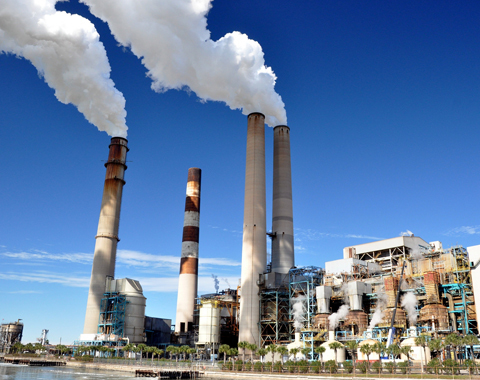
(Photo credit: Walter via Flickr)
What does climate change have to do with economic growth? Canada's prime minister and premiers signed a deal in December to "grow our economy, reduce greenhouse gas (GHG) emissions, and build resilience to the impacts of a changing climate." The Pan-Canadian Framework on Clean Growth and Climate Change outlines plans for carbon pricing, energy-efficient building codes, electric vehicle charging stations, methane emission regulations and more.
Is the framework correct in assuming we can reduce greenhouse gas emissions and grow the economy? If not, which should be given precedence?
These questions come at a pivotal moment in Canadian climate action. The Pan-Canadian Framework marks the first time Canada's first ministers have endorsed a national plan to tackle climate change. It opens the door to a game-changing carbon price that will make reducing greenhouse gas emissions the smart, cost-saving choice for businesses and individuals.
However, a recent Nature Climate Change article claims, "No major advanced industrialized country is on track to meet its pledges to control the greenhouse-gas emissions that cause climate change." Canada pushed for ambitious targets during the 2015 Paris climate negotiations, but even the framework won't put us on track to meet our pledged reductions.
Rather than being an outcome of climate action, economic growth may prevent us from reaching climate targets. A July 2017 study in Nature Climate Change concluded that the world only has a five per cent chance of keeping global average temperature from increasing beyond 2 C. On a positive note, the authors found economies worldwide will likely become more energy-efficient, and low-carbon sources like wind and solar will make up a growing share of the mix.
But economic growth will likely cancel out these advances. For every megatonne of emissions reduced through efficiency and clean energy, another megatonne will be produced because of economic expansion. Our economies will get bigger almost as fast as they get cleaner and emissions will not drop quickly enough to stave off catastrophic climate change.
Economic growth has been the primary goal of every Canadian government, provincial and federal, for decades. Leaders' speeches are peppered with references to it. Election campaigns are filled with promises of economic expansion. Pity the politician who presides over an economic downturn.
Rarely do we stop to ask what economic growth means. In short, it's a year-to-year increase in production, distribution and consumption, as expressed by gross domestic product.
If GDP strikes you as a poor indicator of well-being, you're not alone. The late U.S. politician Robert F. Kennedy once remarked that GDP "measures everything, except that which makes life worth living." It's a flawed indicator of progress.
The Pan-Canadian Framework expresses optimism that we can reduce emissions while expanding the economy. This promise of "green growth" is popular because it offers something for everybody. It maintains a commitment to economic growth while claiming greenhouse gas emissions will drop. But, as the Nature Climate Change study asserts, "green growth" is likely an oxymoron.
"Degrowth" advocates argue that tackling climate change requires shrinking the economy. A planned slowdown of the economy would be achieved by implementing shorter workweeks and more holidays and encouraging low-consumption lifestyles.
"Agrowth" advocates such as environmental economist argue that we should ignore GDP altogether, and instead evaluate progress using indicators such as literacy, employment, rates of diabetes and heart disease, water and air quality and climate stability. If GDP happens to go up while these indicators improve, so be it. If GDP goes down while other measures of well-being increase, what have we truly lost?
When the Pan-Canadian Framework is implemented, some economic sectors will likely grow. Companies that offer low-carbon energy sources, energy-efficient products and opportunities to offset or store greenhouse gas emissions will prosper. Other sectors, like coal mining for power production, will shrink. We may or may not have "clean growth," but we will have a cleaner economy and a better shot at preventing or mitigating climate change's most harrowing effects.
If moving beyond the Pan-Canadian Framework is at odds with growing the economy, let's make sure our elected officials have their priorities straight. Reducing greenhouse gas emissions should take precedence over economic growth.
Hey! Want more DSF? Join David Suzuki on Facebook

September 11, 2017
People just like you are living off the land
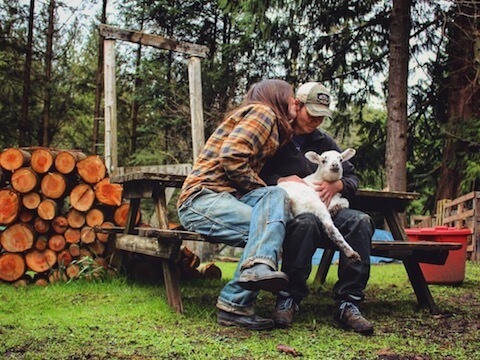
"In a world of more than seven billion people, each of us is a drop in the bucket. But with enough drops, we can fill any bucket." ~ David Suzuki
Métis singer-songwriter/university student/beekeeper Liv Wade and Christi Salyn, who runs a property management business, own and operate Heartfelt Farm on Salt Spring Island, B.C.
Liv grew up in the country. Christi was a city kid. Their mutual love for nature, animals and a healthy, sustainable lifestyle brought them together to grow food and enjoy the benefits of being close to the land.
Where did you learn to run a successful farm?
Liv: From the time I could walk, I was around animal care/farm life -- in 4H and on my aunt and uncle's farm. I was in a serious car accident while living in Vancouver. I decided to connect back to where I felt myself the most -- to nature, animals and family -- to heal. I also took a beekeeping program.
Christi: I had many homes and jobs on farms. My first job on Salt Spring was in a natural food store on a 10-acre farm. I felt inspired to learn all I could about the lifestyle. I asked endless questions to old farmers. I collected hundreds of books at garage sales and thrift stores.
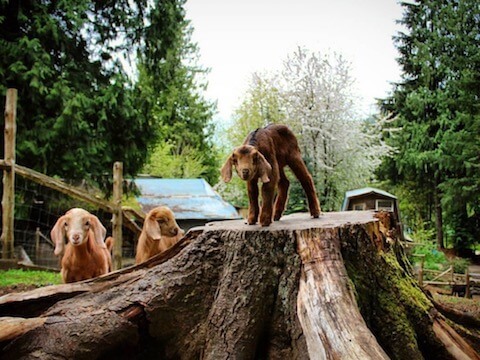
How is your way of life healing?
Liv: Spending time in nature focuses you to be aware. If I go into my hives and I'm not present, I'm not going to do a thorough job. The bees won't be as healthy to do their work. On the farm, if you're not aware of the animals/plants needs, they won't thrive and neither will we!
Christi: This life is healing for me on so many levels, from the health benefits of eating farm-grown food to the effects of animal relationships. This lifestyle pushes you to see what you are made of in ways you couldn't imagine. It's helped me to feel proud of what I can accomplish. This last eight years I've built up nutritious soil through a composting program using farm waste!

What are the greatest lessons you've learned?
Liv: Since running the farm with Christi, I've learned to let go at the end of each day and to listen carefully. My connection to the land has taught me that nature is sacred and should be respected. I've also learned to reach out to the community, as there are others out there with incredible knowledge to share.
Christi: My biggest lessons come with births and deaths. Olivia and I have been through many of both. We provide our animals with a great life. And while most times are enjoyable, sometimes hard things happen. In celebrating the joys and braving through tragedy, I get to meet different aspects of myself. I learn to let go and I learn how to dig deep when I feel I have nothing left. Olivia is by my side doing it all with me, always reminding me "we got this."
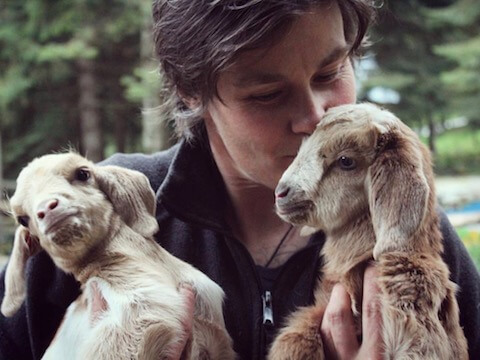
How does Heartfelt Farm promote sustainability?
Liv: When I share what we are trying to do daily, it piques others' interest and inspires them to try, too.
Christi: Our focus is self-sustainability and sharing knowledge with others, not off-farm sales. We grow as much of what we consume as we can. We connect with other farmers to ask and give advice on everything from growing and raising crops to processing and preserving.
What have been your challenges?
Liv: We've faced discrimination as women and as a lesbian couple. We welcome young to old on the farm to learn basic skills. For the most part, people respect what we're doing.
Christi: People sometimes do a double take when I load up a hay trailer or take out my chainsaw to fall a tree. But their reactions just make me smile.
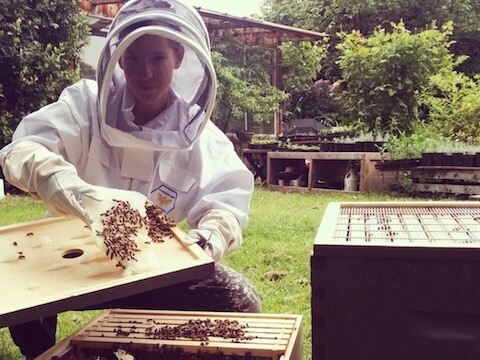
What's your advice for sustainable, self-sufficient living?
Liv: Start with something, even if it seems small and insignificant. Build your knowledge base by connecting with your local community and reading books. Educate yourself. Take local workshops/classes.
Christi: Just do it. I lived in the city for the first 25 years of my life, only ever owned a cat and didn't like getting dirty. I started reading books, talking to farmers and went through lots of trial and error. The work is hard but the benefit is great. I have never been happier or healthier.

Do you know someone who deserves recognition for doing exceptional work protecting nature? Nominate a green leader from your community by commenting on this blog or through the Queen of Green facebook.
Sincerely,
Nikki Sanchez, a fellow Queen of Green
Hey! Want more DSF? Join David Suzuki on Facebook

Eco-certifications fail to hold Canadian fisheries and aquaculture accountable for their full environmental impacts
HALIFAX, VANCOUVER -- Seafood eco-certifications by two prominent organizations are falling short, according to a new report by SeaChoice, a coalition of Canada's leading sustainable seafood advocacy organizations. What's behind the label? Assessing the impact of MSC and ASC seafood certifications in Canada is the first review of whether the Marine Stewardship Council and Aquaculture Stewardship Council have improved sustainability in Canadian seafood production.
With two-thirds of Canadian fisheries MSC-certified, and an industry goal to achieve ASC certification for all British Columbia farmed salmon by 2020, it is crucial these eco-labels are credibly applied and delivering genuine improvements 'on the water'.
SeaChoice found that, over the past decade in Canada, MSC catalyzed engagement of the fishing industry in sustainability issues and led to important progress in management transparency, timely research and information availability. However, it has fallen short in helping reduce critical fishing impacts, such as harm to ocean habitats and threatened species. Only 15 per cent of certification requirements to improve such collateral impacts have led to tanglble change in fishing practices. SeaChoice also found that deadlines for fisheries to meet mandatory improvements were often not met. Some fisheries have up to nine years after certification to fully achieve MSC requirements, all the while continuing to use the eco-label on products.
"Reducing the full ecosystem impacts of fisheries is necessary for a thriving ocean and so we have healthy fisheries for generations to come," says Shannon Arnold, report author and Marine Policy Coordinator at the Ecology Action Centre. "If the MSC fails to hold its fisheries accountable for promised improvements, the label will no longer act as an incentive for change. We worry it is just rewarding status quo. We need more than that to get to truly sustainable fisheries in this country."
For ASC, SeaChoice found frequent deviations from the '100 per cent compliance' it requires for the salmon standard. British Columbia farms regularly have "non-conformities" and rely on "variances" to the standard criteria to be certified. Variances to overcome minor technical difficulties (e.g., a missed sampling date because of bad weather) make sense, but variances in B.C. frequently change standards or defer to government. "It has never been more important to reduce the impacts of open-net aquaculture on wild salmon," says Kelly Roebuck, report author and SeaChoice representative from Living Oceans Society. "Yet, after only two years, ASC is undermining any potential improvements by overriding the multi-stakeholder agreements that established the standard in order to accommodate industry norms."
SeaChoice also found the full impact of farmed salmon is often not assessed because up to a year of the production cycle may never be audited against the ASC standard. ASC's suspension and revocation rules for certified farms that violate the standard's requirements also appear inadequate or underused. One certified farm that experienced several sea lion deaths, a breach that would have prevented initial certification, has twice successfully sent salmon to market with the ASC label.
"While MSC and ASC are the leading seafood-certification systems, our analysis revealed very real risks to the credibility and application of both labelling schemes," says Susanna Fuller, SeaChoice steering committee member. "This ultimately leads to a lack of trust in the standards and the certification processes. MSC and ASC must address key concerns we identified if they truly aim to contribute to a sustainable future for our oceans."
SeaChoice is committed to working with both certification schemes on recommended improvements as well as with government regulatory agencies to ensure that Canada's laws and policies for fisheries and aquaculture operations set a high bar for sustainability. SeaChoice representatives will be attending the World Seafood Congress which starts today in Reykavik, Iceland where eco-certifications, seafood traceability and labelling are key topics of discussion.
-- END --
Media contact:
Sarah Foster, SeaChoice National Coordinator p: (604) 916 9398 e: info@seachoice.org
About SeaChoice
SeaChoice is a collaboration of three internationally recognized organizations -- the David Suzuki Foundation, Ecology Action Centre and Living Oceans Society -- that use their broad, national expertise to find solutions for healthy oceans. SeaChoice is working toward a new and ambitious goal of increasing sustainability throughout the entire seafood supply chain, from water to table. SeaChoice is a member organization of the Conservation Alliance for Seafood Solutions, and works with consumers, retailers, suppliers, government and producers to accomplish its objectives. For over a decade, SeaChoice member organizations have participated in MSC and ASC standard advisory committees (including the Salmon Aquaculture Dialogue Steering Committee), contributed to their standard development consultations and actively engaged on fishery and farm audits.
Background information
Reports can be downloaded here:
What's behind the label? Assessing the impact of MSC and ASC seafood certifications in Canada
http://www.seachoice.org/whats-behind-the-label
The review
What's behind the label? Assessing the impact of MSC and ASC seafood certifications in Canada is the first review undertaken of all Canadian MSC and ASC certifications. It examines if and how these third-party schemes are contributing to improving the environmental sustainability of Canadian fisheries and aquaculture operations.
Marine Stewardship Council Review (MSC) key findings
Since 2008, 36 MSC certifications have been granted in Canada, covering 80 per cent of fisheries landings by value and 66 per cent of landings by volume.
In many cases, MSC has acted as a catalyst for increased data transparency, improved research and analysis and more timely policy implementation from the government.
MSC Fishery certification holders and Fisheries and Oceans Canada respond to MSC certification requirements and have invested resources to meet some of the certification milestones as demonstrated by efforts to complete conditions of certification related to the target stock and management policies.
SeaChoice's analysis identified major concerns with the how the MSC certification is being implemented in Canada including:
Only 15 per cent of certification requirements for improvements of a fishery's impact on the ecosystem and habitat or bycatch and threatened species result in fisheries making tangible changes in how they fished.
Timeline extensions and flexible interpretation of standard requirements are reducing MSC's credibility in Canada.
Due to time extensions and generous allowances for fisheries to meet requirements these fisheries are taking 7 - 9 years from when the labelled product is on the shelves to be at MSC "global best practice" level.
Fisheries have lost MSC certification when the health of their target fishing stock went below acceptable population levels, however no Canadian fishery has lost their MSC certification for failing to meet deadlines to improve impacts on bycatch species, endangered species, or damage to ocean floor habitat
With the majority of Canadian fisheries MSC-certified, there may be little leverage left for further improvements until the MSC Fishery Standard requirements are raised and more strictly implemented.
Stakeholder comments are rarely substantively addressed, despite significant time commitments to engaging in the third-party certification.
In light of these findings, SeaChoice views the best strategic engagement with MSC in Canada is 1) working to improve remaining non-certified fisheries in their "pre-MSC assessment" phase; 2) raising the bar for minimum best practice required by the MSC standard; and 3) ensuring credible and rigorous application of new certification requirements. SeaChoice believes the most significant opportunity to affect sustainability improvements in Canadian fisheries is through direct engagement in government fisheries management processes and industry outreach.
Aquaculture Stewardship Council Review (ASC) findings
Around 25 per cent of active B.C. salmon farms are ASC-certified, with the first farm certified in 2015.
Direct operational reduction in environmental impacts as a result of certification are therefore difficult to determine.
Emerging patterns of implementation of the salmon standard in Canada suggest the ASC is lowering its sustainability bar to accommodate current industry practices. Key examples include:
ASC's claim of 100 per cent compliance to be certified is misleading.
A total of 167 non-conformities have been raised against B.C. salmon farms, and variances deviating from the standard criteria have been used 64 times.
Without the approved sea lice variances, no B.C. salmon farm would be certified had the standard been applied as written.
At least nine farms were certified without assessment of their intermediary farm stage, leaving up to a year from the production cycle unassessed for compliance.
ASC's suspension and revocation rules were found to be inadequate. The rules allow for certified farms in major violation of the standard's requirements that would have otherwise disqualified them from initial certification to enter the marketplace with the ASC label.
SeaChoice identified several leverage points and offers key recommendations to strengthen the eco-certification scheme over the long term, particularly as significant changes are expected in the ASC scheme in 2017-2018. These include harmonizing all individual single species standards under one standard and enabling groups of farm sites to be certified at once (i.e., instead of individually). SeaChoice argues that these shifts will move the ASC further away from the original intent of the multi-stakeholder agreements that established the standard(s).
Hey! Want more DSF? Join David Suzuki on Facebook

September 7, 2017
Nature offers solutions to water woes and flood risks
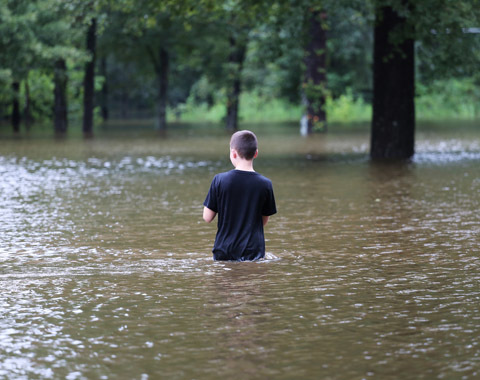
(Photo Credit: Jill Carlson (jillcarlson.org) via Flickr)
When the Aztecs founded Tenochtitlán in 1325, they built it on a large island on Lake Texcoco. Its eventual 200,000-plus inhabitants relied on canals, levees, dikes, floating gardens, aqueducts and bridges for defence, transportation, flood control, drinking water and food. After the Spaniards conquered the city in 1521, they drained the lake and built Mexico City over it.
The now-sprawling metropolis, with 100 times the number of inhabitants as Tenochtitlán at its peak, is fascinating, with lively culture, complex history and diverse architecture. It's also a mess. Water shortages, water contamination and wastewater issues add to the complications of crime, poverty and pollution. Drained and drying aquifers are causing the city to sink -- almost 10 metres over the past century!
"Conquering" nature has long been the western way. Our hubris, and often our religious ideologies, have led us to believe we are above nature and have a right to subdue and control it. We let our technical abilities get ahead of our wisdom. We're learning now that working with nature -- understanding that we are part of it -- is more cost-effective and efficient in the long run.
Had we designed cities with nature in mind, we'd see fewer issues around flooding, pollution and excessive heat, and we wouldn't have to resort to expensive fixes. Flooding, especially, can hit people hard in urban areas. According to the Global Resilience Partnership, "Floods cause more damage worldwide than any other type of natural disaster and cause some of the largest economic, social and humanitarian losses" -- accounting for 47 per cent of weather-related disasters and affecting 2.3 billion people over the past 20 years, 95 per cent of them in Asia.
As the world warms, it's getting worse. Recent floods in Bangladesh, India, Pakistan and Nepal have affected more than 40 million people, killing more than 1,000. One-third of Bangladesh is under water. In Houston, Texas, Hurricane Harvey has killed dozens and displaced thousands, shut down oil refineries and caused explosions at chemical plants. Some say it's one of the costliest "natural" disasters in U.S. history.
Although hurricanes and rain are natural, there's little doubt that human-caused climate change has made matters worse. More water evaporates from warming oceans and warmer air holds more water. Climate change is also believed to have held the Houston storm in place for longer than normal, and rising sea levels contributed to greater storm surges.
A lax regulatory regime that allows developers to drain wetlands and build on flood plains has compounded Houston's problems. The city has no zoning laws, and many wetlands and prairies -- which normally absorb large amounts of water and prevent or lessen flood damage -- have been drained, developed or paved over. President Donald Trump also rescinded federal flood protection standards put in place by the Obama administration and plans to repeal a law that protects wetlands. Compare Houston to Amsterdam and Rotterdam, which sit below sea level. Regulation and planning have helped the Dutch cities lower flood risk and save money.
As climate disruption accelerates in concert with still-increasing greenhouse gas emissions, people are looking for ways to protect cities from events like flooding. In China, authorities are aiming to make them more sponge-like. A Guardian article explains: "Designers will concede to the wisdom of nature to ensure water is absorbed when there's an excess: instead of water-resistant concrete, permeable materials and green spaces will be used to soak up rainfall, and rivers and streams will be interconnected so that water can flow away from flooded areas." As well as offering flood protection, the measures will also help prevent water shortages.
Cities worldwide have employed many of these flood-protection measures, including in the U.S. If China goes beyond its 16-city pilot project, it will be the largest-scale deployment of such combined measures ever.
Restoring natural areas costs much more than protecting them in the first place, more intense and frequent storms and floods can still overwhelm natural defences, and growing human populations will further stress resources, but restoring natural assets is a start.
Ultimately, we must work with nature to prevent and adapt to problems such as flooding, water scarcity, wildfires and climate disruption. When we work against nature, we work against ourselves.
Hey! Want more DSF? Join David Suzuki on Facebook

September 6, 2017
Removing Bloor bike lane would be mistake, Olympic cyclist says

This fall, Toronto city council will debate whether to make the Bloor bike lane a permanent feature.
If councillors vote against it, the lane (currently a pilot) could be removed -- its road markings obliterated, its "flexi-post" dividers yanked out of the ground.
It's a possibility that Olympic cyclist Curt Harnett finds baffling. "Why would we go backwards and remove bike lanes? Drivers are adapting to them. We're all getting used to them," he says.
Harnett is the recipient of three Olympic medals -- two bronze for the match sprint and a silver for the 1,000-metre time trial -- and makes his home in Toronto's east end.
He says he likes bike lanes because they make the street safer for everyone. "I think separated lanes are the better way -- distinct spaces for bikes and cars keep each out of the other's way. They help us all get along."
The Olympian contrasts the sometimes-negative view of cycling in Toronto with the sport's status in much of Europe. "I've spent years riding in France and Italy," he recalls, "and the attitude to cycling there is very supportive. In Provence, for example, cycle-tourism is huge. So their attitude to bike riders is more positive -- which leads to positive attitudes to bikes in the cities."
Despite his passion for cycling, the Canadian Sports Hall of Fame inductee isn't afraid to offer riders constructive criticism. Last year while biking across Toronto's Bloor viaduct with his daughter he felt fellow cyclists created a dangerous situation by passing too quickly. "Cyclists do need to be more cognizant of the rules, of our place on the road," he says. "We need to share and compromise."
Whether one is piloting an automobile or operating a bicycle, one needs to exercise caution. "Bikers need to be aware of what's going on behind them and in front. They need to treat their riding just as they would their car-driving," Harnett argues.
Unafraid to critique cyclists, the Olympic Hall of Fame member also has advice for motorists. The latter should realize bike lanes are not onerous. "We need drivers to understand that it's good for them to have these safety zones."
The lanes foster increased bike use and that means society as a whole enjoys greater convenience and health benefits. Given this, Harnett wonders why removal of the Bloor lanes would even be considered.
"Taking them away would just be a mistake," he concludes.
MAKE THE BLOOR BIKE LANE PERMANENT
Hey! Want more DSF? Join David Suzuki on Facebook

August 31, 2017
Study finds Exxon misled the public by withholding climate knowledge

(Photo credit: Mike Mozart via Flickr)
Coal, oil and gas are tremendous resources: solar energy absorbed by plants and super-concentrated over millions of years. They're potent fuels and provide ingredients for valuable products. But the oil boom, spurred by improved drilling technology, came at the wrong time. Profits were (and still are) the priority -- rather than finding the best, most efficient uses for finite resources.
In North America, governments and corporations facilitated infrastructure to get people to use oil and gas as if they were limitless. Companies like Ford built cars bigger than necessary, and although early models ran on ethanol, the oil boom made petroleum the fuel of choice. Public transit systems were removed and governments used tax revenues to accommodate private automobiles rather than buses and trains.
The oil industry fulfilled many of its promises and became the main driver of western economies. It increased mobility and led to job and profit growth in vehicle manufacturing, oil and gas, tourism and fast food, among others. Petroleum-derived plastics made life more convenient.
The industry boom and the car culture it fuelled had negative consequences, though -- including injuries and death, rapid resource exploitation, pollution and climate change. Plastics are choking oceans and land.
Are these unintended consequences? When did people learn burning large quantities of fossil fuels might be doing more harm than good? Evidence suggests scientists, governments and industry knew all along there would be a steep price to pay for our excesses.
In the late 1800s, Swedish scientist Svante Arrhenius warned that burning fossil fuels and increasing carbon dioxide emissions would initiate feedback loops and increase water vapour in the atmosphere, causing global temperatures to rise. Scientific evidence for human-caused global warming has since increased to the point of certainty, but while few would dispute that burning coal, oil and gas causes pollution and public health problems, many still believe the role of fossil fuels in climate change is contentious.
There's a reason for that: According to volumes of research by journalists, investigators and academics -- including a new peer-reviewed study -- some of industry's largest players have long been deceiving the public about climate science.
The new study, by Harvard's Geoffrey Supran and Naomi Oreskes and published in Environmental Research Letters, analyzes 40 years of research and communications by Exxon Mobil. "Our findings are clear: Exxon Mobil misled the public about the state of climate science and its implications," Oreskes and Supran write in a New York Times opinion article. "Available documents show a systematic, quantifiable discrepancy between what Exxon Mobil's scientists and executives discussed about climate change in private and in academic circles, and what it presented to the general public."
Taking up Exxon's challenge to "Read all of these documents and make up your own mind," the researchers examined the company's scientific research, internal memos and paid public-facing "advertorials." They concluded that, although the company knew of and communicated internally about its product's climate impacts and the danger of it becoming a "stranded asset," it told the public a different story.
Exxon placed paid opinion articles in the New York Times between 1989 and 2004, at a cost of US$31,000 each. Contrary to the company's own research and internal communications -- as well as overwhelming scientific evidence from around the world -- the articles argued, among other things, that, "The science of climate change is too uncertain to mandate a plan of action that could plunge economies into turmoil," and, "We still don't know what role man-made greenhouse gases might play in warming the planet."
Oreskes and Supran also note Exxon is being sued by current and former employees and investigated by the New York and Massachusetts attorneys general and the federal Securities and Exchange Commission. Much relates to whether the company "misled consumers, shareholders or the public about the environmental or business risks of climate change, or about the risk that oil and gas reserves might become stranded assets that won't be developed, affecting shareholder value."
Given climate change's serious implications, the fact that fossil fuel companies, aided by compromised governments and shady "think tanks" and media outlets, would put fossil fuel profits ahead of human health and survival is an intergenerational crime against humanity. We should commend Oreskes and others for their tireless efforts to bring this truth to light.
Hey! Want more DSF? Join David Suzuki on Facebook

August 24, 2017
When times get dark, we must shine brighter

(Photo credit: Mark Dixon via Flickr)
Are we entering a new Dark Age? Lately it seems so. News reports are enough to make anyone want to crawl into bed and hide under the covers. But it's time to rise and shine. To resolve the crises humanity faces, good people must come together.
It's one lesson from Charlottesville, Virginia. It would be easy to dismiss the handful of heavily armed, polo-shirted, tiki-torch terrorists who recently marched there if they weren't so dangerous and representative of a disturbing trend that the current U.S. president and his administration have emboldened.
Racism, hatred and ignorance aren't uniquely American. Fanatics acting out of fear -- of anyone who holds different political or religious views, of losing their real or imagined privilege, of change itself -- are everywhere.
But whether they're religious or political extremists or both, all have much in common. They're intolerant of other viewpoints and try to dehumanize those who are different; they believe in curtailing women's and minority rights even though they claim to oppose big government; they espouse violence; and they reject the need for environmental protection.
Charlottesville was a tipping point, not so much because hatred and ignorance were on full display (that happens all too often), but because so many people stood up and spoke out against it, and against President Donald Trump's bizarre and misguided response.
The effects spilled into Canada, most notably with the implosion of the far-right (and misnamed) media outlet The Rebel. The online platform, born from the ashes of the failed Sun News network, is a good illustration of the intersection between racism, intolerance and anti-environmentalism. Rather than learning from Sun News's failure that racism and extremism are unpopular and anti-Canadian, Rebel founder Ezra Levant ramped up the bigoted and anti-environmental messaging, with commentators ranting against feminists, LGBTQ people, Muslims and Jews (Levant is Jewish), along with rejecting climate science and solutions to environmental problems!
The Rebel's Faith Goldy was at Charlottesville, sympathetically "reporting" on the band of mostly male white extremists. When a racist drove his car into a crowd of anti-Nazi protesters, killing 32-year-old Heather Haley and seriously injuring others, it was too much for some of Levant's long-time supporters.
Rebel staff and commentators -- including a co-founder -- cut their ties. Norwegian Cruise Line cancelled a scheduled Rebel fundraising cruise, hundreds of advertisers pulled out and principled conservatives dissociated themselves. Trying to salvage the site's ragged reputation, Levant fired Goldy.
Meanwhile, the White House is in disarray and damage control around the president's unhinged tweets, the ongoing Russian-influence investigation, constant firings -- including chief strategist Steve Bannon -- and legislative paralysis, not to mention a stupid belligerence that brought us to the brink of nuclear war!
At first it appeared that the tide of intolerance, emboldened racism and anti-environmentalism was rising, but now it's looking more like the last desperate efforts of a minority of small-minded people to hold onto ideas and perspectives that history has proven wrong many times.
Canada and the U.S. have checkered racist and colonialist pasts, but for all our faults, we've been evolving. Thanks to many people with diverse backgrounds from across the political spectrum who have devoted themselves to civil rights, feminism, Indigenous causes, LGBTQ rights, the environment and more, we've made many gains. We have a long way to go, but we must keep on and not let fear, hatred and ignorance block our way.
If we and our children and their children are to survive and be healthy in the face of crises like climate change and terrorism, we must stand together -- in unity and solidarity, without fear. Like the many who gathered in Barcelona the day after recent horrendous terrorist attacks, the people who stood up to racists in Charlottesville, those who reject the anti-human agendas of media outlets like The Rebel, and the many people worldwide who march and speak up for climate justice, we must come together to shine a light on the darkness.
We must use our voices, actions and humour to confront these anti-human undercurrents. We must confront our own prejudices and privilege.
Love conquers fear and hate. We must show those who want to bring us down or take us back to darker times that we outnumber them by far, everywhere.
Hey! Want more DSF? Join David Suzuki on Facebook

August 22, 2017
Why Olympian Adam van Koeverden supports bike lanes

Adam cycling on the Goat Creek Trail near Banff-Canmore. (Credit: Paula Findlay)
People can't be divided neatly into cyclists and motorists, says Adam van Koeverden.
The 2004 winner of the Lou Marsh Trophy, given to Canada's top athlete, is himself a driver on some days, a bike-rider on others. He's not alone. "Most cyclists also spend time in a car, taxi or Uber," he explains. The goal isn't taking sides but finding a way for all road-users to move safely through the city. Toward that end, he supports separated bicycle lanes.
"If there's no lane, it's a scramble," says van Koeverden, who was once sent to hospital after being doored by a truck driver. "But when a lane's been installed there's an order to the road -- there's a place for cars and a place for bikes."
The issue is successful cohabitation: protected lanes allow two- and four-wheeled vehicles to live securely side-by-side.
The two-time world champion and Olympic gold-medallist in sprint kayak likes what he sees in Europe. In Germany, Denmark and the Netherlands, for example, the relationship between automobiles and bikes is much less adversarial. There's "less 'us versus them'," he argues. There's an understanding that protected lanes also benefit drivers because "when I'm driving I don't want to hit a cyclist."
As well, European motorists realize that the more people use bikes, the less congestion there is for those taking the car.
Van Koeverden, 35, has been a Toronto cyclist since 2008. His motivation is largely pragmatic. "I use my bike a lot. It makes total sense to save money on parking and gas. It's just practical." In addition to using the bike for commuting, he enjoys riding dirt trails in the city's rugged Don Valley. "It's a little known fact that we have really, really good mountain biking in the heart of the city," he told the Metro newspaper in June.
As a kayaker, van Koeverden spends much time in lakes. Not surprisingly, he has a passion for water, sports and the environment -- issues he generously supports as an ambassador for WaterAid, Right to Play and the David Suzuki Foundation. His charitable work takes him across the country and around the world: Right to Play is supporting Indigenous youth in Canada; WaterAid is building wells in African nations.
Back home in Toronto, he's endorsing the Bloor bike lanes, which come to a council vote this fall. He hopes city hall will make the lanes -- currently a pilot -- into permanent features.
Asked what single message he'd send the mayor regarding the Bloor lanes, he answers succinctly, "Keep them." Their great value, he suggests, is building civic harmony. "I listen to experts and I haven't heard anyone dispute the value of peaceful co-existence between bicycles and autos."
Hey! Want more DSF? Join David Suzuki on Facebook

David Suzuki's Blog
- David Suzuki's profile
- 247 followers



